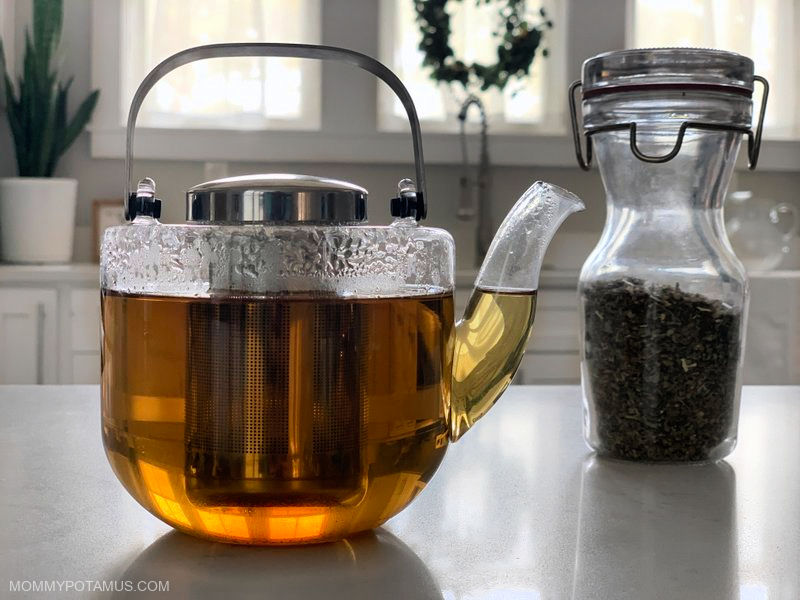
Unless you happen to own the cat that was caught on video breaking into a pet store and finding bliss in the catnip aisle, you might be wondering why you should care about this little herb with heart-shaped leaves. Yes, it’s beloved by cats everywhere, but it’s also amazing for people who need to relax, sleep deeply, and/or are looking for some extra digestive or immune support.
So basically people.
So what is catnip, and how does it benefit me?
Catnip (Nepeta cataria), also called catmint, is a little different from adaptogens (which help with stress) and other herbs that work best when used consistently over a period of time. This member of the mint family is mostly helpful in one-off situations, like when you need to unwind after a particularly stressful day.
Catnip is what herbalists call a “relaxing nervine,” which means it has a calming effect on the central nervous system (CNS). It’s revered for its ability to create a sense of peace, calm overstimulation, and ease forehead tension and motion sickness. Considered a mild sedative, it’s often sipped as an herbal tea before bed to help with sleep.
Before we dive into its other uses, I want to mention that none of these statements have been evaluated by the FDA, this article is not medical advice, and it is not meant to diagnose or treat any condition. Please talk with your healthcare provider about any herbs you are considering. Now that we’ve got that out of the way, let’s take a look at the benefits.
Health Benefits & Uses
In addition to its calming properties, catnip may be helpful for:
- Muscle Relaxation: Catnip tea has traditionally been to ease tense muscles, especially when uncomfortable cramps and menstrual cramps are present. Current research supports this approach. (1)
- Respiratory Support: Clinical studies suggest that the essential oils found in catnip may have bronchodilating properties, which may explain its traditional use for supporting respiratory function. Bronchodilators relax bronchial muscles, allowing for expansion of the bronchial air passages. (1)
- Digestive Support: Catnip is classified as carminative (flatulence reliever), herbal bitter (supports digestion), and astringent (substance that tightens tissues and soothes inflammation). This combination is not often found in many herbs, and it makes catnip tea especially useful for digestive issues like upset stomach, gas, indigestion and heartburn.
- Immune Support: Several Indigenous American tribes used catnip for immune support, especially in cases of fevers or colds. (2)
- Mosquito Repellent & Bug Spray: According to researchers, “nepetalactone, the essential oil in catnip that gives the plant its characteristic odor, is about ten times more effective at repelling mosquitoes than DEET — the compound used in most commercial insect repellents.” (3) The EPA’s guide to insect repellents also lists it as one of three oils that are helpful for repelling ticks – citronella (Cymbopogon winterianus) and lemon eucalyptus (Eucalyptus citriodora) are the other two. I use the essential oil in my homemade bug spray/homemade tick spray, and my dogs flea and tick powder.
- Wound Care: Used as a compress or topical wash for wounds.
- Emotional Well-Being & Stress Support: As mentioned above, catnip is often sipped as an herbal tea to relax tension and support restful sleep. This study also found it can be helpful for easing feelings of nervousness.
How do I use catnip?
The easiest way to use dried catnip leaves is to make them into tea by steeping 1-2 teaspoons of dried herb in hot water – I’ve included a recipe below. Catnip is not known to be toxic, so you can likely use as much as is needed until you achieve the acute support you desire.
Another option for incorporating catnip is to use a tincture. An adult catnip tincture dose of 30-40 drops 3x/day is suggested. Here’s an alcohol-free version if you prefer that.

Catnip Tea Recipe
Ingredients
- 1-2 tsp organic dried catnip leaves (or 1-2 tablespoons fresh catnip leaves)
- 1 cup boiling water
Instructions
- Pour boiling water over the catnip leaves and steep for five to seven minutes.
- Strain and add honey/maple syrup to taste if desired.
Notes
Is catnip easy to grow?
Yep! Although this perennial herb is native to parts of Asia and Europe, it’s now super easy to grow in a sunny window just about anywhere. Outdoor cultivation is also an option if you’re in zones 3-9 in the United States. Something to be aware of is that, just like other forms of mint, the catnip plant can take over your garden. I prefer to plant it in a large pot that gives lots of room while also keeping it contained.
Growing tips: The easiest approach is to buy seedlings from an organic nursery, but they’re also pretty easy to grow from seeds like these. Catnip loves full sun, soil with good drainage, and regular watering. Harvest the leaves and flowers after the plant has started to flower – usually between May and September – and use twice as much fresh as you would dried.
Why do cats love catnip, anyway?
Ahh, great question. Apparently nepetalactone, which is the essential oil component that bugs hate, is responsible for the euphoria cats seem to experience. When nepetalactone hits their olfactory bulb, experts think the cats brain interprets it as a pheromone associated with, uh, romance.
Nepetalactone doesn’t affect all cats – just about 70-80% – and only those that have reached reproductive maturity. Kittens under six months old are usually immune. Fortunately there’s no harm in letting cats enjoy this herb in cat toys or pillows. It’s non-addictive and safe, but overindulging can cause a stomach ache.
How safe is catnip?
The Botanical Safety Handbook, 2nd edition, classifies catnip as a Safety Class 1A herb, which is defined as an herb that can be:
“safely consumed when used appropriately.
- History of safe traditional use
- No case reports of significant adverse events with high probability of causality
- No significant adverse events in clinical trials
- No identified concerns for use during pregnancy or lactation
- No innately toxic constituents
- Toxicity associated with excessive use is not a basis for exclusion from this class
- Minor or self-limiting side effects are not bases for exclusion from this class”
However, other sources say that it should be avoided during pregnancy because it may stimulate the uterus and cause a miscarriage. I would steer clear during pregnancy just in case.
3 Catnip Recipes To Try
Products Mentioned In This Post
- Organic dried catnip for making tea (recipe above)
- Stainless steel basket infuser – Makes brewing loose leaf tea just as easy as bagged tea
- Catnip tincture
- Catnip seeds for growing your own catnip if you have a green(ish) thumb
- Medical Herbalism
Article Coauthors: Mommypotamus founder, Heather Dessinger, and Dr. Lori Valentine Rose (PhD). Dr. Rose is a college biology, nutrition, herbal, and wellness instructor, Certified Nutrition Professional (CNP), Registered Herbalist with the American Herbalist Guild, and is Board Certified in Holistic Nutrition. She created, developed, and instructs the Hill College Holistic Wellness Pathway, the most thorough, affordable, degreed wellness program in the country.
Want more research-backed natural remedies?
No problem, I’ve created a free ebook for you – Kitchen Apothecary: 25+ Natural Remedies Using Ingredients From Your Pantry – as a gift for signing up for my newsletter. You’ll also get updates when I post about safe essential oils for pregnant/breastfeeding mamas, exclusive gifts and coupons (I was able to give away a jar of free coconut oil to anyone who wanted it recently!), plus other goodies.
Sign up using the form below.
Sources:
1. Gilani, A.H. (2009) Chemical composition and mechanisms underlying the spasmolytic and bronchodilatory properties of the essential oil of Nepeta cataria L.
2. College of Pharmacy & Health Sciences. Native Medicinal Garden.
3. Science Daily (2001) Catnip Repels Mosquitoes More Effectively Than DEET.
4. Hoffman, David (2003) Medical Herbalism.





